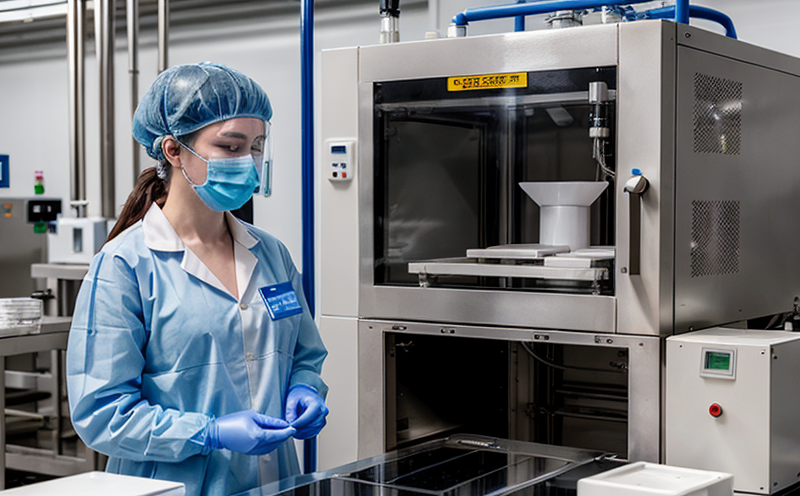GMP Cleaning Process Validation Testing
In pharmaceutical manufacturing, ensuring Good Manufacturing Practice (GMP) compliance is essential to guarantee product quality and safety. GMP cleaning process validation testing plays a critical role in this regard by verifying that cleaning processes effectively remove all residues from production equipment, thereby preventing cross-contamination between batches of different products.
The primary goal of GMP cleaning process validation testing is to demonstrate that the cleaning procedures meet specified standards. This involves rigorous testing and documentation to ensure that any residual material left on surfaces does not affect product quality or purity. Such tests are particularly important in sterile environments where even minute quantities of contaminants could have severe consequences.
The testing procedure typically includes several key steps: first, the cleaning process is documented and defined according to established guidelines such as ISO 14644 for cleanroom classification. Then, samples are collected from various parts of the equipment post-cleaning. These samples undergo analysis using advanced analytical techniques like High-Performance Liquid Chromatography (HPLC), Gas Chromatography-Mass Spectrometry (GC-MS), and Fourier Transform Infrared Spectroscopy (FTIR).
The results of these analyses are then compared against predefined acceptance criteria set forth by regulatory bodies such as the FDA or the European Medicines Agency (EMA). If the results indicate unacceptable levels of contamination, further investigation into the cleaning process is required to identify and rectify any issues.
The importance of accurate testing cannot be overstated. Inaccurate or insufficiently thorough cleaning can lead to product recalls, which not only incur significant financial costs but also damage a company's reputation. By adhering strictly to GMP standards through comprehensive validation testing, pharmaceutical companies can mitigate these risks and maintain high-quality manufacturing practices.
Our laboratory offers state-of-the-art facilities equipped with the latest technology for conducting GMP cleaning process validation tests. Our team of experienced professionals ensures that every aspect of your cleaning protocol is thoroughly evaluated, providing you with reliable evidence of compliance. With our expertise in this field, we can help ensure that your manufacturing processes meet the highest standards and are ready to withstand regulatory scrutiny.
- Compliance with ISO 14644 for cleanroom classification
- Analytical techniques including HPLC, GC-MS, and FTIR
- Detailed comparison against predefined acceptance criteria
- Expert analysis by experienced professionals
Benefits
Implementing GMP cleaning process validation testing provides numerous advantages for pharmaceutical manufacturers. Primarily, it ensures product quality and safety by eliminating potential sources of contamination within the production environment.
From a business perspective, this translates into reduced risks associated with non-compliance penalties, product recalls, and customer trust issues. Additionally, successful completion of these validations can enhance your reputation among industry peers and clients alike, potentially opening doors to new markets or contracts.
On a more practical level, GMP cleaning process validation testing helps streamline operations by identifying inefficiencies in current practices early on. This allows for targeted improvements that can lead to cost savings through optimized resource usage and reduced waste generation. Moreover, it fosters an overall culture of continuous improvement within the organization.
For R&D teams, this service offers valuable insights into process optimization opportunities. By understanding exactly where residues persist despite cleaning efforts, they can explore innovative solutions aimed at improving efficacy and reducing environmental impact. Ultimately, these benefits contribute to a more efficient, safer, and sustainable pharmaceutical manufacturing operation.
International Acceptance and Recognition
GMP cleaning process validation testing is widely recognized across international borders for its importance in ensuring product quality and safety. Regulatory authorities like the FDA and EMA have established stringent guidelines that must be followed, making compliance a global standard.
- FDA Guidance on GMP Compliance
- EMA Guidelines for Cleanroom Classification (PDF download)
- ISO 14644-1:2019 - Clean rooms and associated clean environments – Part 1: Classification of air cleanliness
- ASTM E2532 Standard Practice for Determining the Extent of Cleanliness of a Surface
The consistent application of these standards worldwide ensures that pharmaceutical products meet high safety standards wherever they are manufactured or distributed. Laboratories adhering to international norms like ISO 14644 provide assurance not only locally but also internationally, enhancing market access for manufacturers.
International recognition extends beyond mere compliance; it fosters trust among stakeholders globally. This is particularly crucial in today's interconnected world where supply chains traverse multiple countries and regions. Pharmaceutical companies that demonstrate robust adherence to global standards are better positioned to navigate complex regulatory landscapes confidently.
Environmental and Sustainability Contributions
GMP cleaning process validation testing contributes significantly to environmental sustainability within pharmaceutical manufacturing processes. By ensuring effective removal of all residues, these tests prevent waste from reaching landfills or water bodies, thus reducing overall pollution levels.
In addition, optimized cleaning protocols identified during the validation process contribute to resource efficiency by minimizing unnecessary use of solvents and other chemicals. This reduces both operational costs and environmental footprints associated with chemical disposal.
The transparency provided by thorough GMP compliance testing also encourages continuous improvement initiatives aimed at further reducing energy consumption and emissions throughout production cycles. For instance, adopting more efficient filtration systems or exploring renewable energy sources for process heating can be informed decisions based on validated data.
Moreover, adhering to stringent cleaning standards promotes responsible stewardship of natural resources by minimizing contamination risks that could disrupt ecological balance in receiving environments such as rivers and oceans downstream from wastewater treatment facilities.





